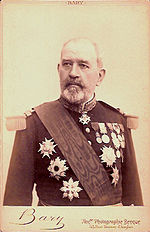| Commemorative medal of the Mexico Expedition | |
|---|---|
 Commemorative medal of the Mexico Expedition (obverse) | |
| Type | Commemorative campaign medal |
| Awarded for | Military service in Mexico 1862-1863 |
| Presented by | |
| Eligibility | French citizens and foreign nationals serving in the ranks of the French Foreign Legion |
| Status | No longer awarded |
| Established | 29 August 1863 |
| Total | ~38,000 |
Ribbon of the Commemorative medal of the Mexico Expedition | |



The Commemorative medal of the Mexico Expedition (French: Médaille commémorative de l'expédition du Mexique) was a French commemorative campaign medal established by decree of French Emperor Napoleon III on 29 August 1863[1] to recognize military service during the 1862-1863 French intervention in Mexico.[2]
The Mexican expedition was undertaken in 1862 on order of Emperor Napoleon III following a financial dispute with the Republic of Mexico and his personal desire to create a Catholic empire on the continent to counterbalance U.S. influence. On 7 January 1862, approximately 3,000 French soldiers landed at Vera Cruz. Small British and Spanish contingents that were originally part of the adventure preferred to withdraw quickly leaving only the French forces assisted by small numbers of Austrian, Belgian and Turkish troops.[3]
These forces, whose numbers would later rise to approximately 38,000 men, were successively placed under the command of generals Charles de Lorencez, Élie Frédéric Forey and finally François Achille Bazaine. The campaign was the scene of some of the most notable battles in French military history, such as the glorious struggle for the village of Camaron where, on 30 April 1863, sixty two legionnaires resisted bravely for nine hours against over two thousand Mexicans, allowing for the capture of the city of Puebla on 17 May 1863 thus paving the way to Mexico. In the capital, an assembly of notables recognized Archduke Maximilian of Habsburg, brother of Emperor Franz Joseph of Austria, as Emperor of Mexico.[3]
However, even with the support of 20,000 Mexicans who embraced the new emperor, Maximilian's forces were harassed in their work of pacification by the troops of President Benito Juárez who had the support of the United States. In February 1867, Emperor Napoleon III ordered the repatriation of all remaining French troops from Mexico, the last elements left the port of Vera Cruz on 12 March 1867. An abandoned Emperor Maximilian, defeated and captured near the city of Querétaro, was executed in June of that year.[3]
- ^ "Imperial Decree of 29 August 1863" (in French). Bibliothèque Nationale de France. 1863-08-29. Retrieved 2013-10-29.
- ^ Musée de la Légion d'Honneur permanent exhibit, Paris
- ^ a b c "France Phaléristique web site" (in French). Marc Champenois. 2004-01-01. Retrieved 2013-10-29.